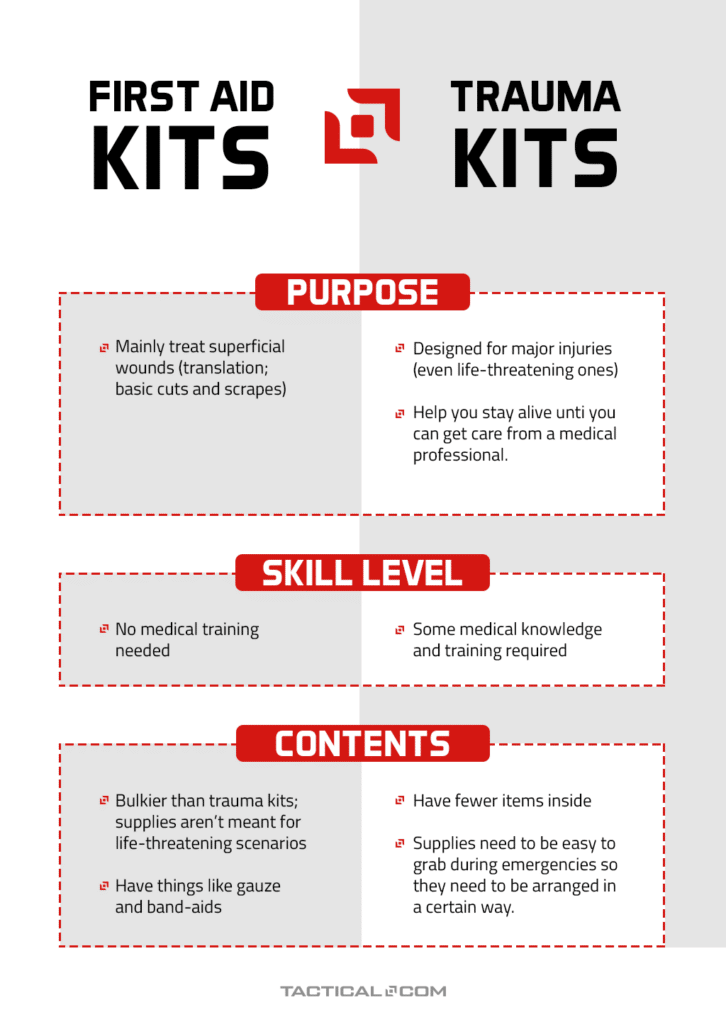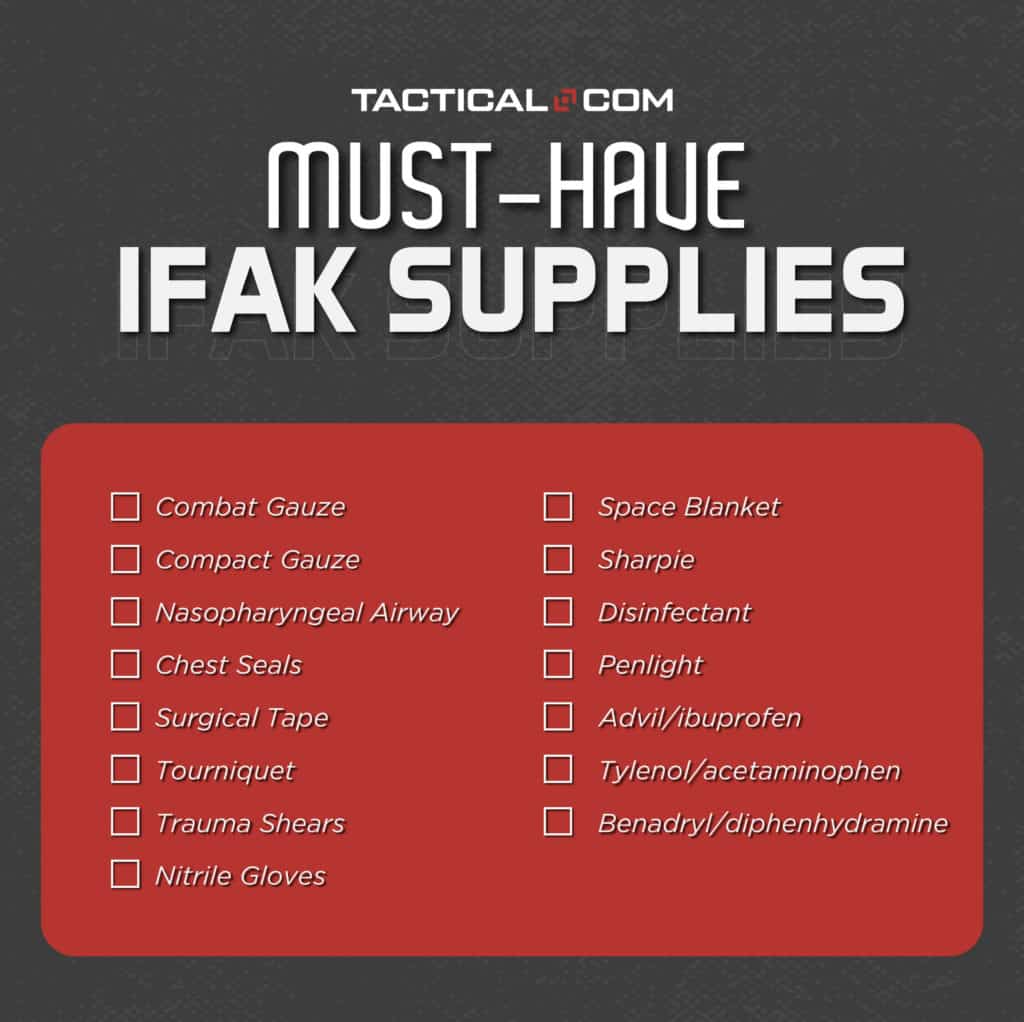Food is running low.
The power stays out.
The masses are getting more scared as the days pass.
Welcome to TEOTWAWKI—population you and the desperate.
In the resounding chaos where violence and who-knows-what take over, your first aid kit won’t be enough. You’ll need an IFAK to help you stay alive.
Here’s what you need to know about IFAKs:
What Is an IFAK?
Before we start explaining what an IFAK is, let’s first distinguish a first aid kit from a trauma kit.
Here’s a simple breakdown of their differences:

Now, IFAK stands for Individual First Aid Kit. Don’t let the name fool you, though. It’s more of a trauma kit than it is a first aid kit.
The military issues IFAKs to all its soldiers. And while the contents may differ depending on whether you’re in the Army, Marines, or Air Force, the purpose is the same. It’s used specifically to treat serious and potentially deadly injuries—injuries that make it hard to breathe or cause nonstop bleeding.
But you don’t have to be in the military to find use for an IFAK. If you want to protect yourself in dangerous situations, having one will come in handy. This brings us to the next section:
When Do You Need an IFAK?
We preppers love our survival kits. We build get home bags, bug out bags, and even I’m Never Coming Home bags to be ready for any situation. Since an IFAK is meant to treat critical injuries immediately, it makes a great addition to any of those bags.
Here are just some of the scenarios where you might need one:
- Civil unrest
- Wild animal attacks
- Living off the grid and being ages away from the nearest hospital
- Natural disasters like hurricanes, earthquakes, and winter storms
How to Make the Most Out of Your IFAK
You’ll find many IFAKs for sale online; some being the exact same ones that the military issues. But while there are pros to buying premade survival kits, in this case, it’s best to select your own supplies for your kit.
Remember what the I in IFAK means. It should suit YOUR lifestyle and needs.
To build the perfect IFAK, follow these tips:
Think MARCH
MARCH is a mnemonic used in trauma care. It stands for:
- Massive hemorrhage
- Airway
- Respiration
- Circulation
- Hypothermia and Head injury
These are the injuries that you might experience during natural or man-made disasters.
Each of them is grave and requires individual treatment. Determine how vulnerable you might be to each injury and pick your IFAK supplies based on that assessment.
Focus on What’s Necessary
IFAKs aren’t meant to be stuffed with everything under the sun. Heck, you shouldn’t even have band-aids in yours. Remember, your IFAK is meant for trauma care. Do you really think a band-aid can stave off a stab to the abdomen?
Each time you want to add survival supplies to your IFAK, ask yourself if you really need them in a life-or-death context and whether you already have something that serves the same purpose.
Know How to Use Your Supplies
This is a given because what good would those survival supplies be if you just buy them and then store them in your IFAK, forgotten until S hits the fan? You’ll need some medical skills to use several of these items, so read up on them, watch tutorials, and practice.
Make It Accessible
You can attach the pouch outside your bag or wear it around your waist—whatever makes it the fastest to reach. Make sure you can access it using either of your hands, too, in case something happens to your dominant one. Other folks should also be able to locate your IFAK pouch easily so that they can treat you if you’re too weak.
What Should Your IFAK Contents Look Like?
Your IFAK should have the following survival supplies:
Combat Gauze
Combat gauze is awesome. It has a hemostatic agent that accelerates blood clotting, meaning it helps you stop medium bleeding quickly.
The gauze also works on wounds with more severe bleeding. It might take more time for the bleeding to quit depending on their size, but it’s still way faster than letting the blood clot on its own.
The con is that combat gauze is a bit on the pricey side. Still, it’s worth every penny.
Compact Gauze
Compact gauze is combat gauze’s cousin. The main difference between the two is that compact gauze doesn’t contain a hemostatic agent. Instead, the gauze is used as backing for it.
While it may not have the same blood clotting power as combat gauze, it still does a bang-up job of absorbing blood. Plus, it’s cheaper. So if you’re on a budget, this gauze is for you.
Nasopharyngeal Airway (NPA) Tube
This tube is what you grab if someone around you has trouble breathing, whether it’s from getting attacked or becoming unconscious after walking for 2 days straight. It sounds like a humongous responsibility, but you don’t have to go to medical school to know how to use it.
Keep in mind, though, that you should NEVER use an NPA if the person’s nose is gushing a lot of blood or if you suspect they have a facial fracture.
Just take the beveled end of the tube and stick it inside the nostrils. Here’s a guide from the Canadian Red Cross that walks you through the whole process.
Chest Seal
No matter how many self-defense classes you’ve taken or how many fortifications you’ve made to your home, there’s always a chance you might get stabbed.
One way to brace yourself for this is by adding chest seals to your IFAK. These are dressings for sucking chest wounds.
Should you get shot or stabbed in the chest, stick a chest seal on the wound site to close it. It will stop air from going into your chest, which also stops the lungs from collapsing and prevents tension pneumothorax.
You can choose between non-vented or vented chest seals, but the vented ones are better because they let air get out of the chest—meaning they prevent more risks.
Surgical Tape
You already have surgical tape in your first aid kit, but get a separate one for your IFAK anyway. This tape makes sure dressings won’t unravel. Most surgical tapes are 1 to 3 inches wide and are available in 10-yard rolls.
Tourniquet
A tourniquet is the way to go when bandages and gauze aren’t strong enough to stem the bleeding in your arms or legs. It cuts off blood flow by putting pressure on the wound.
You can actually make your own tourniquet when you’re in a pinch and left with no options. But as much as possible, go for the legit kind.
Also, be warned: not everyone can apply a tourniquet.
If there’s too much pressure on the injury, you might end up harming yourself more. Don’t use one unless you’ve been trained.
Trauma Shears
Imagine having to undress someone with a big gash on their leg. Or worse, being alone with a stomach injury and having to remove your shirt yourself. That’s why you need a sturdy pair of shears. It can hack off clothes fast and give you better access to the wound.
Gloves
No, we don’t mean the tactical gloves you wear when you practice your bushcraft skills (though those are super badass). We’re talking about nitrile gloves. Being non-allergenic, they prevent the wound from getting infected as well as protect you from germs.
Space Blanket
Take hypothermia seriously. It can be just as dangerous as gunshot wounds and it’s more common than you think. To help prevent it, it pays to have a space blanket. This emergency blanket is useful when you’re out in the wild or bugging out.
Sharpie
Why the heck would you need a marker in your IFAK? Yeah, this isn’t something most folks would expect in a medical kit—but trust us. A marker WILL be helpful.
Use it to write down the following:
- Time of injury
- Time the tourniquet was placed
- Symptoms being experienced
While these might seem like small things, they can give medical personnel the information they need to take appropriate care of you or any other person who gets hurt.
Other Supplies to Add
Make sure you also include the following in your IFAK:
- Disinfectant
- Penlight
- Advil/ibuprofen
- Tylenol/acetaminophen
- Benadryl/diphenhydramine
To wrap up everything up, here are the crucial items to have in your IFAK:

Final Thoughts
Don’t leave out an Individual First Aid Kit when you’re prepping for emergencies—hospitals may be full when SHTF or you might get into an accident during a road trip.
An IFAK isn’t as comprehensive as a first aid kit, but it’s designed to be light and specific. As long as you’re familiar with your IFAK contents, you can save your life or someone else’s when help is too far away.
Has an IFAK ever come in handy for you? Share your experience in the comments below!



